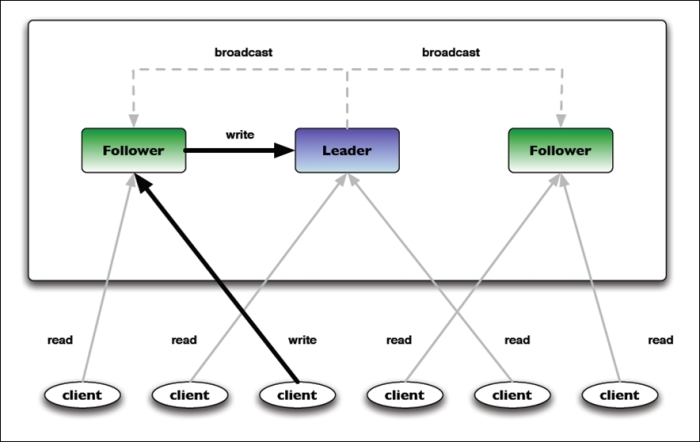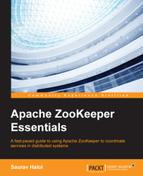ZooKeeper's data model and its API support the following nine basic operations:
Let's look at the ZooKeeper operations mentioned in the preceding table using ZooKeeper Java shell:
- Create a znode called root with
ThisIsTheRootNodeas its data:[zk: localhost(CONNECTED) 0] create /root "ThisIsTheRootNode" Created /root
- Get the content of the just created znode
root:[zk: localhost(CONNECTED) 1] get /root "ThisIsTheRootNode" …… …… …… ……
- Create a child znode
child-1forrootwithThisIsChild-1as its data:[zk: localhost(CONNECTED) 2] create /root/child-1 "ThisIsChild-1" Created /root/child-1
- Create a child znode
child-2forrootwithThisIsChild-2as its data:[zk: localhost(CONNECTED) 3] create /root/child-2 "ThisIsChild-2" Created /root/child-2
- List the children of
root:[zk: localhost(CONNECTED) 4] ls /root [child-2, child-1]
- Get the access control listing for
root:[zk: localhost(CONNECTED) 5] getAcl /root 'world,'anyone : cdrwa
- Deleting the
rootis not allowed asroothas 2 child znodes:[zk: localhost(CONNECTED) 6] delete /root Node not empty: /root
- Delete
child-1:[zk: localhost(CONNECTED) 7] delete /root/child-1 - Delete
child-2:[zk: localhost(CONNECTED) 8] delete /root/child-2 - List the content of
root:[zk: localhost(CONNECTED) 9] ls2 /root [] …… …… …… ……
- Delete
root:[zk: localhost(CONNECTED) 10] delete /root
Apart from the operations described so far, ZooKeeper also supports batch updates to znodes with an operation called multi. This batches together multiple primitive operations into a single unit. A multi operation is also atomic in nature, which means that either all the updates succeed or the whole bunch of updates fails in its entirety.
ZooKeeper does not allow partial writes or reads of the znode data. When setting the data of a znode or reading it, the content of the znode is replaced or read entirely. Update operations in ZooKeeper, such as a delete or setData operation, have to specify the version number of the znode that is being updated. The version number can be obtained by using the exists() call. The update operation will fail if the specified version number does not match the one in the znode. Also, another important thing to note is that updates in ZooKeeper are non-blocking operations.
The read and write operations in ZooKeeper are shown in the following image:

An image that shows the read and write operations in ZooKeeper
From the preceding image, we need to take note of the following two crucial aspects of these operations:
